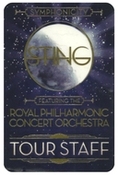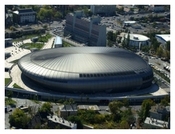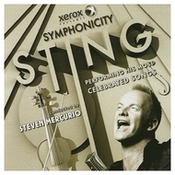
Sting's vibrant elegance...
"There are two kinds of love songs. One is I love you and you love me. It's boring. The other is I love you but you love someone else. It's painful but much more exciting" - Sting introduced his song 'When We Dance' on Saturday evening at the Papp László Sports Arena in Budapest, where he performed as part of his 'Symphonicity' tour.
As it turns out, just like love, pop music has many layers, and the British musician, born Gordon Matthew Thomas Sumner, has now tried combining it with symphonic music. He has embarked on a world tour with the Royal Philharmonic Concert Orchestra in London: he will perform the defining songs of his career in symphonic arrangements.
Of course, combining light and classical music is nothing new; many people from Deep Purple to Metallica have already performed with symphonic accompaniment. However, Sting did not necessarily want to deepen his music with a deep, heavy sound; rather, he emphasized the elegance of his songs through the accompaniment of the 45-piece orchestra.
Some songs did not lose much of their character, 'Englishman In New York', 'Roxanne' or 'She's Too Good For Me' sounded similar to the original sound - but the orchestral parts that introduced and closed the songs, as well as the harmony, showed that the 59-year-old artist has a more contemplative, mature approach to his own work. Sting was not afraid to touch the more dynamic songs of the Police era, and thanks to the bouncy string playing, 'Next To You' or 'Every Breath You Take' took on a distinctly new character.
However, the greatest experience was those pieces from which the classical accompaniment conjured up completely new songs: in these cases, the rethought arrangement meant more than a simple arrangement. The amazing playing and harmony of the wind and string players brought the Russians back to life, and they achieved one of their greatest successes despite the fact that much more famous and popular hits were also played in the arena.
The Royal Philharmonic Concert Orchestra was also a partner in the show: conductor Steven Mercurio's movements were full of momentum and dance moves, but the musicians were not afraid to encourage the audience with applause. Sting communicated in a true professional way - he told stories, shared his thoughts on the songs on some numbers, and vibrated on stage despite his sophisticated performance.
The duality of the concert also affected the audience, who were only seated: sometimes the audience seemed to be under the influence of the atmosphere of large concert halls and only applauded restrainedly, and sometimes they created an almost wild party atmosphere.
The latter made the production better because at this time the often disturbing internal echo of the arena was not heard - it was true that it could not have been an easy task to create a sound suitable for a 45-piece orchestra in a room of this size. However, the experience overshadowed this, especially when the first encore song, 'Desert Rose', which could almost be called disco in the original, was played with elemental force - by this time the packed arena was already standing and clapping, dancing and singing.
© Kronika
11062010
SET LIST
- If I Ever Lose My Faith In You
- Every Little Thing She Does Is Magic
- Englishman In New York
- Roxanne
- Straight To My Heart
- When We Dance
- Russians
- I Hung My Head
- Shape Of My Heart
- Why Should I Cry For You?
- Whenever I Say Your Name
- Fields Of Gold
- Next To You
- A Thousand Years
- This Cowboy Song
- Tomorrow We'll See
- Moon Over Bourbon Street
- End Of The Game
- You Will Be My Ain True Love
- All Would Envy
- Mad About You
- King Of Pain
- Every Breath You Take
- Desert Rose
- She's Too Good For Me
- Fragile
- I Was Brought To My Senses




